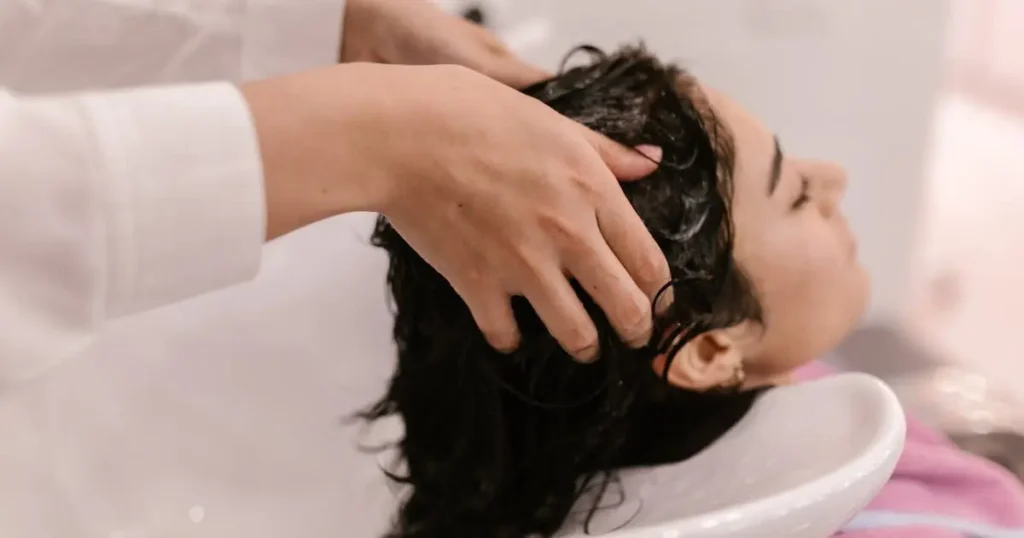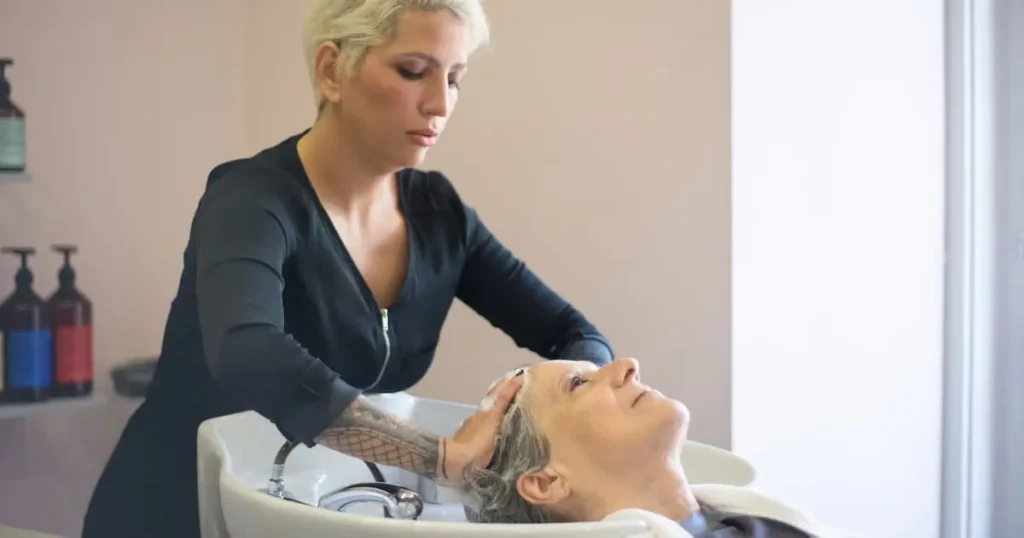Figuring out the right hair washing routine can be tricky, especially for those with curly locks. Washing too often can lead to dryness and damage, while washing too little can cause oil buildup and scalp issues. So what’s the sweet spot? Here’s a detailed look at how to determine the ideal curl washing schedule.
Curly hair is a unique and beautiful texture that demands a specialized care routine. Among the many questions that arise in the realm of curly hair care, one of the most pivotal is determining the optimal frequency for washing. Striking the right balance is crucial for maintaining the health and vibrancy of your curls. In this guide, we’ll delve into the science behind curly hair care. Discover the secrets to unlocking the full potential of your curls as we explore various washing strategies tailored to the specific needs of curly locks.
The Case For Less Frequent Washing

Unlike straight hair, curly hair tends to be drier and more prone to damage from over-washing. There are a few key reasons why:
Natural Oils
The natural oils produced by the scalp have a harder time traveling down thick, curly hair strands. When you wash too often, these oils get stripped away before they have a chance to moisturize the ends.
Shampoo Effects
Common detergents in shampoos, like sulfates, tend to be harsh and drying for curly textures. Too much scrubbing can cause frizz, breakage and disrupted curl patterns.
Water Diffusion
When wet, curly hair takes longer to dry out. Remaining damp for long periods can allow moisture levels to get thrown off balance.
The Case For More Frequent Cleansing
While keeping those natural oils intact is crucial, going too long without washing curly hair comes with its own set of problems.
Product Buildup
The many gels, mousse and sprays used to style curly hair will inevitably leave behind residue. Letting products accumulate on the scalp and strands can lead to irritation and limp, lifeless curls over time.
Excess Oil
Not shampooing often enough causes excess oil build up at the roots. This greasy residue not only looks unpleasant but can hinder moisture from properly being absorbed into the strands.
Scalp Health
Leaving sweat, dead skin cells, dirt and other debris on the scalp for extended periods breeds bacteria and raises the risk of infection. This can lead to itching, flaking and even acne.
Finding The Right Curl-Care Routine
So when navigating between the two extremes of under-and-over washing curly hair, what wash frequency is actually best? Here are some tips on striking the right balance:
Adjust According To Your Hair
Curl type plays a major role in determining ideal wash frequency. Looser wave patterns tend to require more frequent cleansing than thick, tight coils which need built up oils for definition. Take your hair’s needs into account.
Wash Day Schedule
To maintain balance, set a consistent wash day schedule rather than waiting until hair “feels” dirty. For many, washing 1-2 times a week is ideal. Adjust up or down if hair becomes too oily or dry in between washes.
Use Gentler Products
Harsh shampoos strip vital oils, so opt for cleansing products free of sulfates, silicones and parabens. Likewise, use plenty of moisturizing conditioner and masks to replenish hydration.
Don’t Overdo Other Heat/Chemical Styling
Use heat tools sparingly, allowing hair to air dry when possible. Limit chemical processing like perms, relaxers and dye which can dry out curls further and require more frequent washing. Protect hair to avoid additional damage.
Give Clarifying Periodic “Resets”
While gentler products help retain moisture and curl shape day-to-day, allowing product buildup can still eventually occur. Using a detoxifying clarifying shampoo once a month helps remove this excess debris for a “reset.”
Additional Cleansing-Related Considerations

Beyond figuring out a customized wash frequency schedule, there are a few other things those with curly hair should consider regarding their cleansing routine for optimal health:
Wash In Sections
Curls easily become a tangled mess in the shower. Comb through conditioner in small sections to prevent ripping wet knots wide open when scrubbing shampoo directly onto the full head.
Scrub The Scalp
Focus scrubbing efforts on the scalp rather than lengths of hair, moving fingertips in gentle, massaging motions to lift dirt and buildup without disrupting curl clumps.
Rinse Thoroughly
Residual cleanser left behind can continue stripping moisture, especially with coarser, thicker hair types. Be sure to rinse until the water runs completely clear.
Change Up Products
Using the same shampoo consistently can cause it to lose effectiveness over time as hair gets used to it. Rotating between a couple trusted products helps keep them working optimally.
Signs You Need To Wash Curly Hair More/Less Frequently
As finding the right curly hair wash balance is undoubtedly a process of trial and error, it helps to keep an eye out for signs you may need to adjust your current regimen.
Signs You Should Wash Curly Hair More Frequently:
- Lots of oil buildup, limp locks
- White flakes or dandruff on scalp
- Itchy skin or infected hair follicles
- Thin, lifeless curls lacking definition
- Strong odor from scalp area
- Growth of mold or bacteria on wet products
Signs You Should Wash Curly Hair Less Frequently:
- Noticeably drier strands
- Hair seeming constantly thirsty
- Increased tangles and breakage
- Disrupted curl pattern
- Lots of frizz, lack of clumping
- Irritation from scalp (despite no buildup)
- Need to excessively moisturize lengths
Pay attention to these cues from your hair. If needed, tweak your current wash routine accordingly.
What About Co-Washing?

Some curly girls swear by “co-washing” as a gentler cleansing alternative. This involves using a conditioning cleanser instead of shampoo to remove dirt and oil between regular washings.
Potential Benefits
- Keeps hair shafts moisturized
- Less drying than sulfate shampoos
- Allows longer between stripping washes
- Good for mild daily grime removal
- Leaves curls soft and detangled
Who Should Avoid It
- Those prone to quicker buildup
- Fine or thinner hair types
- People who lead active lifestyles
- Anyone needing true deep cleaning
While co-washing helps some, the heavier conditioning elements may still lead to eventual buildup for many curl types. Pay attention to how hair responds.
Shampooing Tips For Healthy Curly Hair
Once you’ve determined an ideal wash frequency, be sure to use the right techniques during cleansing for glossy, lively curls:
Choose Products Without Harsh Elements
Skip shampoos with sulfates, silicones and parabens which can strip natural moisture, disrupt curl formation and irritate the scalp.
Use Lukewarm Water
Hot water can destroy hair cuticles leading to frizz. Lukewarm is safest, but finish rinses with cool water to boost shine.
Work Into A Creamy Lather
Rub a quarter-sized dollop between palms before applying directly onto damp hair, working up a rich lather. Target the scalp rather than lengths.
Give A Quick Scalp Massage
Gently use pad of fingers to lift dirt while stimulating circulation for a healthy scalp. Don’t aggressively pile or tug hair.
Rinse Until Water Runs Clear
Residual shampoo left on the hair continues cleansing. Make sure to rinse thoroughly with head tipped forward.
Follow With Conditioner
Hydrating conditioner helps counteract shampoo stripping effects. Apply from roots to ends, allowing a few minutes to penetrate before rinsing.
Drying Curly Hair The Right Way
After finding your wash routine sweet spot, it’s equally important todry strands using best practices to lock in moisture. Here are some top tips:
Blot Out Initial Moisture First
Gently squeeze out excess dripping water using an old cotton shirt or microfiber towel. Rubbing strands causes frizz and stretches the delicate curl pattern.
Don’t Rough Dry
Either let hair air dry fully or use a diffuser attachment on the lowest heat/speed setting to avoid causing volume reduction or heat damage over time.
Add Leave-In Conditioner
Work a moisturizing leave-in treatment through sections from roots to ends before air drying or diffusing for extra protection and sheen.
Set With Styling Products
Use a curl-friendly mousse, cream or gel to encourage the curl shape as hair dries. Apply these upside down for better volume distribution.
Touch Up Roots If Needed
If the roots begin drying too quickly compared to lengths, clip hair up while finishing drying ends then come back for spot touch-ups.
Maintain Consistency
Stick to the same general drying method to avoid inadvertently causing heat damage, frizz or disrupted textures over time.
What If You Must Heat Style Frequently?
Some curly haired folks use blow dryers or hot irons/curling wands more regularly to achieve certain styles. Here are expert tips for minimizing heat damage:
Invest In Quality Tools
High-end tools often come equipped with settings for different hair types, allowing more control over amount of heat exposure.
Always Use A Heat Protectant
Spray hair thoroughly with a thermal shield before applying any hot tool to help negate some damaging effects.
Take Supplements
Certain supplements help strengthen hair over time, reducing how much heat processing can wear down the structure. Biotin, folic acid and Omegas can help.
Use The Cool Shot Button
Finish off blow outs by blasting with cold air to help seal and smooth the hair cuticle closed instead of leaving it hot and vulnerable.
Alternate Heated And Non-Heated Styling
Balance occasional heat usage with also wearing hair curly or allowing waves to air dry to avoid compounding harsh effects session after session.
What Are The Pros And Cons Of Co-Washing Curly Hair?

Co-washing, short for “conditioner washing,” has both good and not-so-good points those with curly hair should consider before incorporating into their routine.
Pros:
More Hydration Using conditioning cleansers keeps moisture locked in better than harsher surfactant-based shampoos.
Less Disruption Of Texture The gentler co-wash process leaves delicate curl patterns more intact.
Easier Detangling Thick curly hair knots easily when washing. Conditioner-based co-washes provide more slip.
Allows Longer Between Shampoos True shampooing too often dries curls out. Co-washing removes some debris between washes.
Time Saving One product to cleanse and condition makes wash days simpler.
Cons:
Can Cause Buildup
Ingredient oils may still leave residue for some hair types.
Weighs Down Fine Strands
The extra conditioning elements make limp locks.
Insufficient Deep Cleaning Great for surface dirt but can’t replace a true occasional clarifying shampoo to remove months of product accumulation.
Increased Bacteria Risk The heavier moisturizing films on the scalp can provide an environment for bacterial overgrowth.
Ineffective With Lots Of Sweat/Pollution Co-washing won’t adequately remove heavy grime, chlorine, salt and chemical pollutants.
The decision depends greatly on your individual curl type, styling regimen and environment. Weigh the good versus not-so-great based on your personal situation.
Can You Train Curly Hair To Need Less Washing?
Many curly haired folks wonder if you can actually train hair over time to require less frequent cleansing. The answer is yes…to an extent.
It Is Possible To Stretch Wash Days:
Your Scalp And Strands Adjust Producing less oil is a natural adaptation to less shampooing stripping it away so often.
Using Dry Shampoo Helps These absorbent powders soak up grease so hair feels fresher between washes.
Gentle Cleansing Conditioners Work Co-washing gives a quick freshen up without stripping away the scalp’s gradually decreasing oils.
Getting Past The Initial Transition Powering through the first few weeks of limp, oily hair is pivotal to giving your body time to adjust to less washing.
But There Are Limits:
Oil Production Plateaus The scalp never stops producing oil entirely. There is a threshold where sebum increases levels back off.
Excess Sweat, Grime And Irritation During illnesses, infections, overly strenuous exercise and summertime humidity, extra washing still crucial.
Product Residue Accumulation
Oils and silicones in styling products eventually require removal even if natural oil production has slowed.
Depending On Your Curl Type
Looser waves and curls stand a better chance of stretching washes than thicker, coiled textures. YMMV.
While reaching 2+ weeks between wash days works for some curly types, most still require occasional clarifying for scalp and strand health over time.
Should You Wash Curly Hair Before Or After Styling?

Deciding whether it’s better to cleanse locks before or after styling relies heavily on your specific curl goals. Consider the difference:
Washing First Benefits:
Debris/Oil/Buildup Removal Shampooing first ensures curls start styling with the cleanest, freshest canvas.
Unobstructed Product Application Water rinses away any pre-existing oils, silicones and creams allowing new products to absorb uniformly.
More Predictable Results Seeing styling results on dirty hair makes it harder to tell if something in your regimen needs changing.
Prevents Scalp Issues The wash helps remove dead skin cells, sweat and other grime that styling products could seal against the skin.
Styling First Advantages:
Curl Memory Skip the shriveling water exposure to maintain the established curl shape day-to-day.
Consistent Definition Products like gel applied to dry hair help set strands in clumps better than washing out then attempting to re-form curls.
Conclusion
In conclusion, determining how often to wash curly hair involves a personalized approach that considers various factors. By following the three easy steps outlined in this guide—understanding your hair type, considering external influences, and experimenting with different frequencies—you can discover the perfect balance for your curls. Remember that there is no one-size-fits-all answer, and the key lies in paying attention to your hair’s unique needs. Achieving the right washing frequency is a journey of self-discovery that leads to healthier, more vibrant curls. Embrace the process, and enjoy the beauty of your curls with confidence.
FAQs Related To -How Many Times A Week Should You Wash Curly Hair
Here are some of the most frequently asked questions people have:
Why is the frequency of washing crucial for curly hair?
The frequency of washing is critical for curly hair because it impacts the natural oils and moisture balance. Washing too often or too infrequently can affect the health and appearance of curls.
What are the key factors influencing the ideal washing frequency for curly hair?
Several factors come into play, including hair type, texture, lifestyle, and environmental conditions. These factors contribute to the determination of the optimal washing frequency for maintaining healthy and vibrant curls.
How can I determine my hair’s specific needs when it comes to washing?
Understanding your hair type and experimenting with different washing frequencies is a good starting point. Pay attention to how your curls respond to different routines and adjust accordingly.
Are there any recommended products for washing curly hair?
Sulfate-free, moisturizing shampoos and conditioners designed for curly hair are often recommended. Additionally, incorporating leave-in conditioners or curl creams can contribute to hydration and frizz control.
Can the climate affect how often I should wash my curly hair?
Absolutely. Humidity levels and environmental conditions can impact the moisture content of your hair. Adjust your washing frequency based on the climate to maintain the health and shape of your curls.
